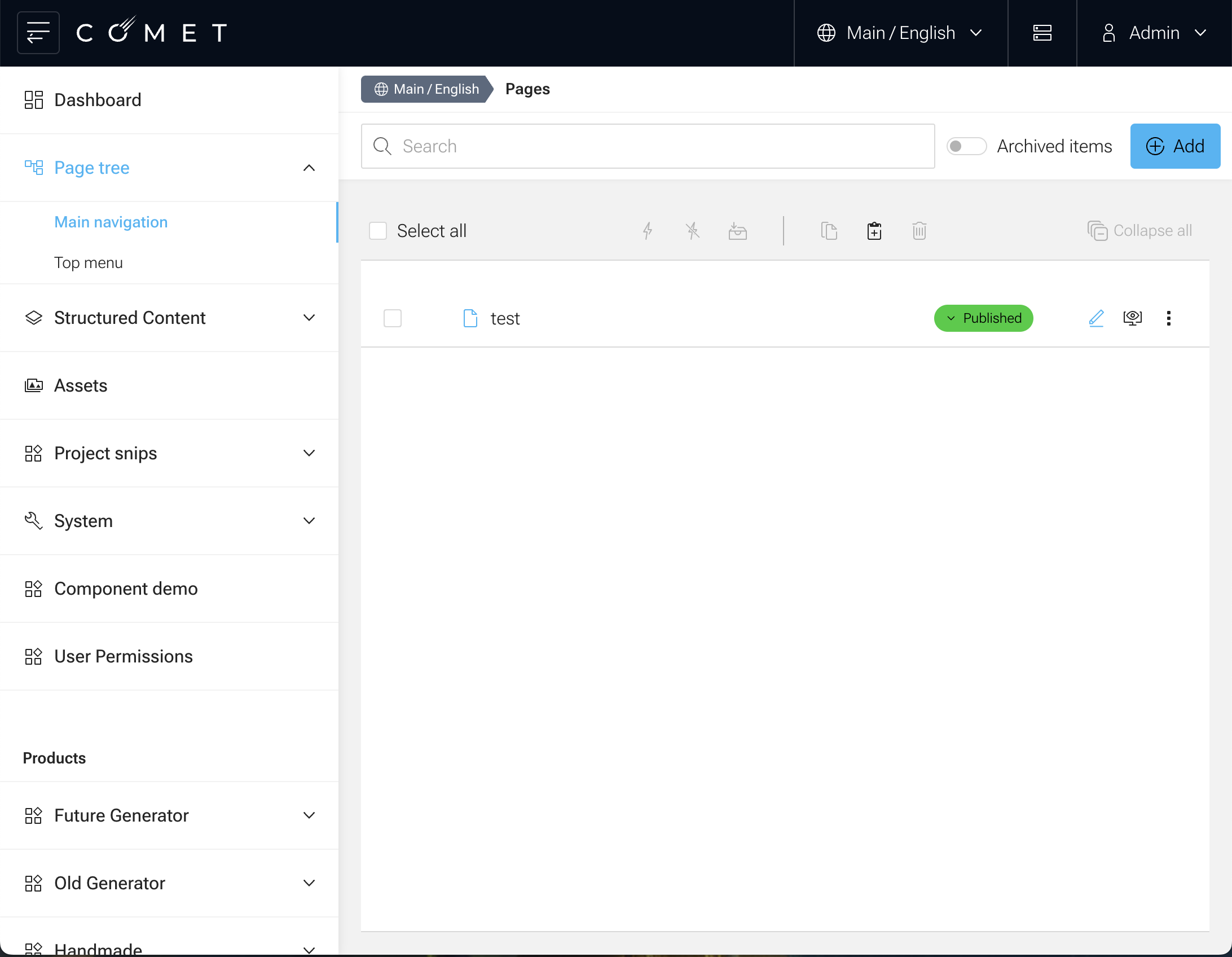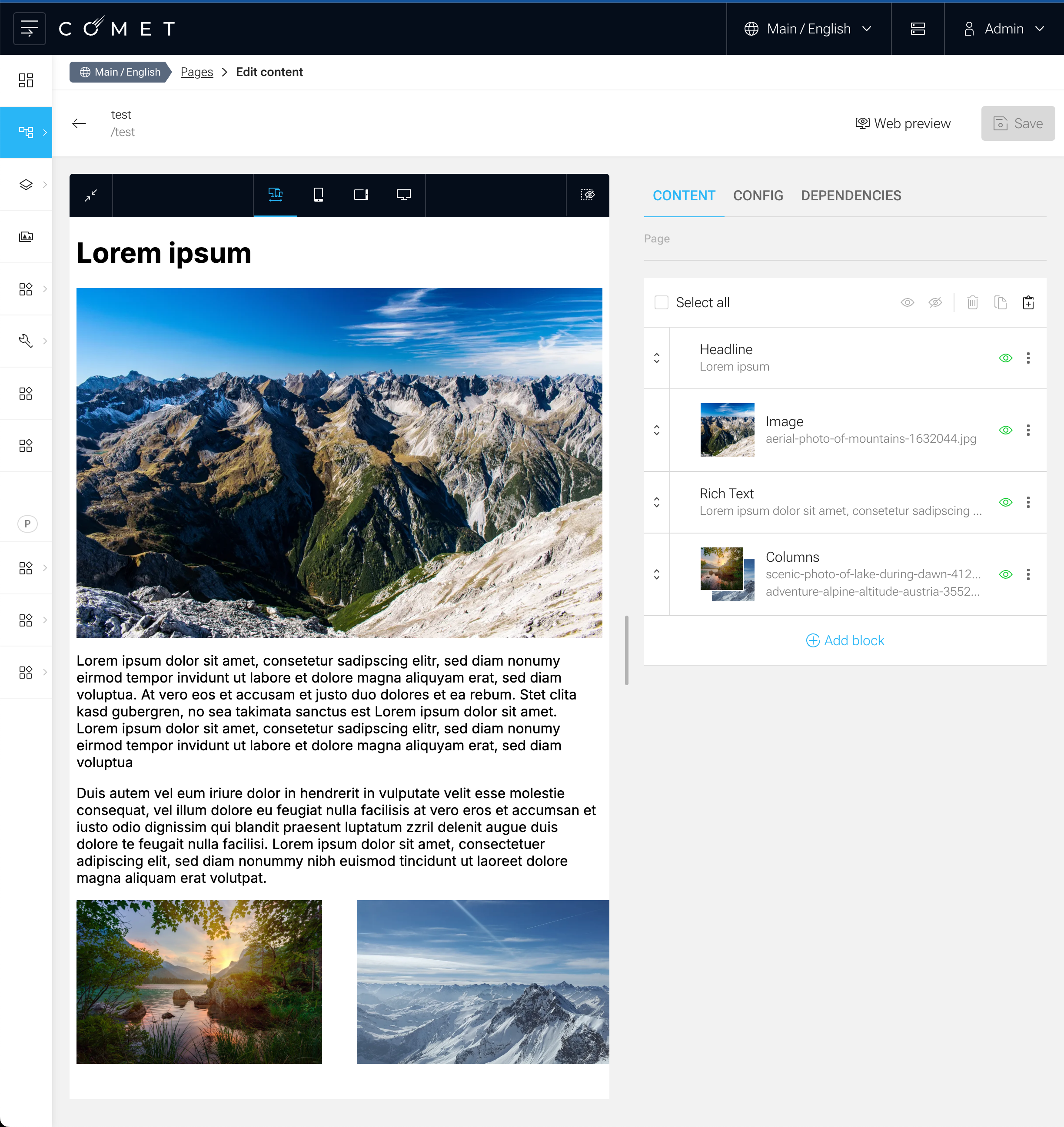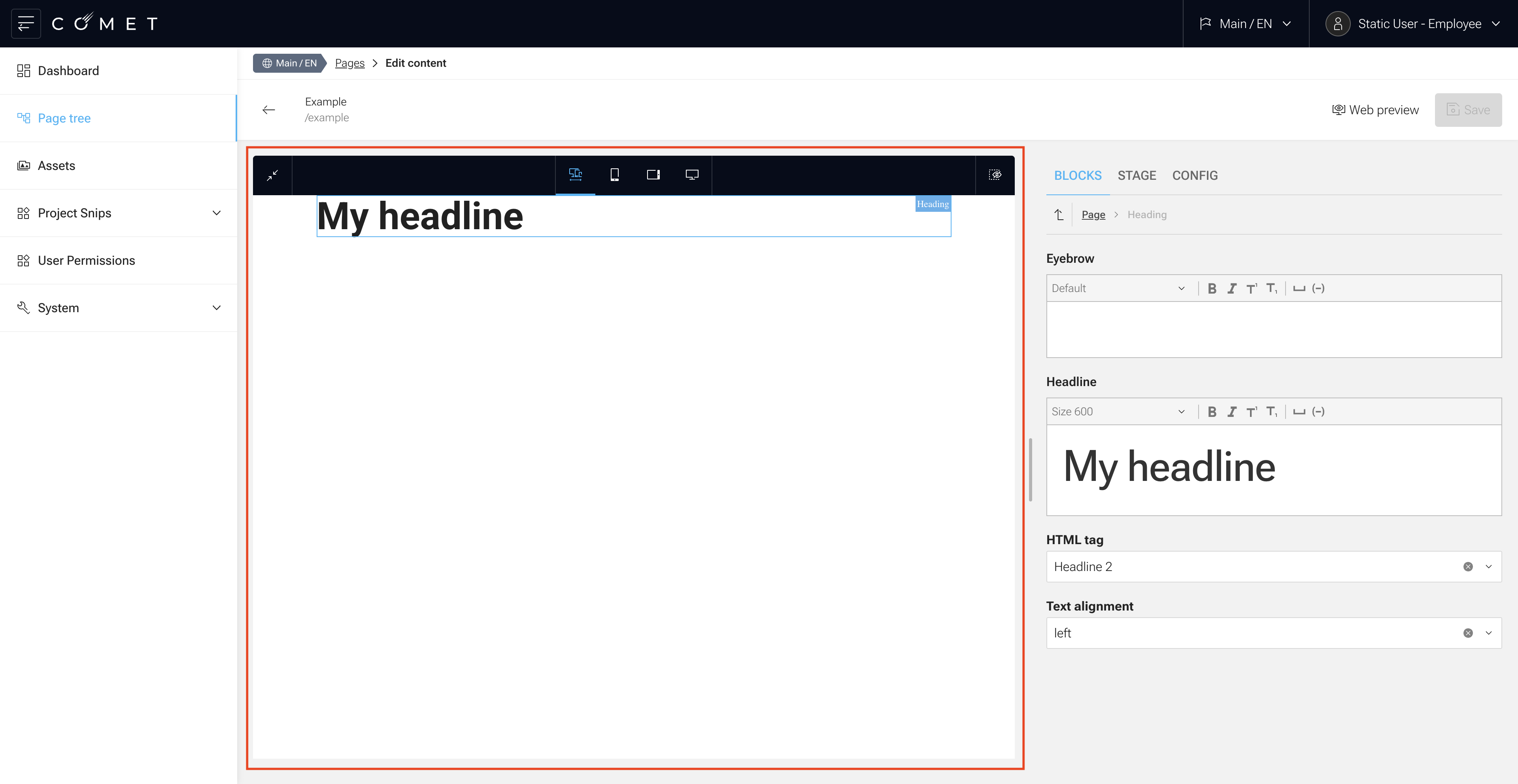How to build a custom client
We usually use Next.js to build our site client. This guide will show you how to build a custom client for your Comet DXP and render a typical content page from the page tree.
For this guide, we will assume you use React but not Next.js.
In this case, you can use the @comet/site-react package to build your custom client:
npm install @comet/site-react
Loading documents (pages)
In COMET DXP, content is organized in a hierarchical tree structure called the page tree. Each page tree node has a document attached to it, which can be a page, a link or other content types.
A sample page tree list can look like this:

Page Tree Node List
To load/see all page tree nodes, you need to query the pageTreeNodeList field in the Query type.
This field allows you to fetch a list of PageTreeNode objects based on specific criteria such as contentScope and category.
These values differ from project to project and are defined by the project's requirements.
There is also another query, paginatedPageTreeNodes, which is more performant for large page trees.
The following query fetches all PageTreeNode objects and includes their id, name, path and slug:
query Pages($contentScope: PageTreeNodeScopeInput!, $category: String!) {
pageTreeNodeList(scope: $contentScope, category: $category) {
id
name
path
slug
}
}
A response will then look similar to this:
{
"data": {
"pageTreeNodeList": [
{
"id": "7c151a7f-7e0c-4103-8d34-216421f4cdcf",
"name": "test",
"path": "/test",
"slug": "test"
}
]
}
}
With that information in place, we can now query the page content based on the PageTreeNode's id.
Documents
In Comet DXP, documents are the content entities that can be attached to page tree nodes.
The documents depend on the project configuration and can vary widely.
The most common document type is the Page, which consists of blocks and represents one page of your website.
The following example show a content page that includes a HeadlineBlock, ImageBlock, RichTextBlock, and a ColumnBlock containing two ImageBlock elements:

Loading page data
As said before, we are working with page content attached to a page tree node.
The page tree is a tree structure that contains all the pages in the system.
Each page tree node has an id that can be used to fetch the page data from the API.
Note: Blocks can also be attached to other data (e.g., structured data, news, ...). Loading and rendering will be similar, but also a bit different depending on the use case.
To fetch the corresponding data, we will make use of the pageTreeNode field in the Query type.
The pageTreeNode field returns a PageTreeNode object that contains the necessary page data.
type Query {
pageTreeNode(id: ID!): PageTreeNode
}
type PageTreeNode {
id: ID!
path: String!
document: PageContentUnion
}
union PageContentUnion = Page | Link # The PageContent Union can contain many more entries, we are focusing now on the Page type.
type Page implements DocumentInterface {
id: ID!
content: PageContentBlockData!
}
scalar PageContentBlockData
@specifiedBy(url: "http://www.ecma-international.org/publications/files/ECMA-ST/ECMA-404.pdf")
To query the page data, we can use the following query:
query Page($id: ID!) {
pageTreeNode(id: $id) {
id
path
document {
... on Page {
content
}
}
}
}
In situations where you don't have the id at hand, you can also query the page tree node based on its path using the pageTreeNodeByPath query:
query Page {
pageTreeNodeByPath(path: "/", scope: { domain: "main", language: "en" }) {
id
path
document {
... on Page {
content
}
}
}
}
The received content is a Comet DXP PageContentBlockData Scalar and contains a root block which is basically a JSONObject that contains the block data.
Full Sample Response
{
"data": {
"pageTreeNode": {
"id": "7c151a7f-7e0c-4103-8d34-216421f4cdcf",
"path": "/test",
"document": {
"content": {
"blocks": [
{
"key": "9d261397-6d62-4d6e-8934-0b627f4af4e4",
"visible": true,
"type": "headline",
"props": {
"eyebrow": "",
"headline": {
"draftContent": {
"blocks": [
{
"key": "8i42j",
"text": "Lorem ipsum",
"type": "unstyled",
"depth": 0,
"inlineStyleRanges": [],
"entityRanges": [],
"data": {}
}
],
"entityMap": {}
}
},
"level": "header-one"
},
"userGroup": "All"
},
{
"key": "83a341d4-723c-422f-beea-5d3b1a31a10c",
"visible": true,
"type": "image",
"props": {
"attachedBlocks": [],
"block": {
"type": "pixelImage",
"props": {
"damFile": {
"id": "59d72281-9ae9-4351-b37b-6efc01a54842",
"name": "aerial-photo-of-mountains-1632044.jpg",
"size": "6412063",
"mimetype": "image/jpeg",
"contentHash": "4c16d34b98b993a8864a599cbbd419e0",
"title": null,
"altText": null,
"archived": false,
"scope": {
"domain": "main"
},
"importSourceId": null,
"importSourceType": null,
"image": {
"width": 6000,
"height": 4000,
"cropArea": {
"focalPoint": "SMART",
"width": null,
"height": null,
"x": null,
"y": null
},
"dominantColor": "#324f63"
}
},
"urlTemplate": "http://localhost:4000/dam/images/067e080ba5e484cde929c866d5d26814bead1b58/59d72281-9ae9-4351-b37b-6efc01a54842/crop:SMART/resize:$resizeWidth:$resizeHeight/aerial-photo-of-mountains-1632044"
}
},
"activeType": "pixelImage"
},
"userGroup": "All"
},
{
"key": "bdf6c7be-a1cc-4f83-85be-16a221d94eb2",
"visible": true,
"type": "richtext",
"props": {
"draftContent": {
"blocks": [
{
"key": "9uhi2",
"text": "Lorem ipsum ...",
"type": "unstyled",
"depth": 0,
"inlineStyleRanges": [],
"entityRanges": [],
"data": {}
},
{
"key": "adu0d",
"text": "",
"type": "unstyled",
"depth": 0,
"inlineStyleRanges": [],
"entityRanges": [],
"data": {}
},
{
"key": "8t7f1",
"text": "Lorem ipsum ...",
"type": "unstyled",
"depth": 0,
"inlineStyleRanges": [],
"entityRanges": [],
"data": {}
}
],
"entityMap": {}
}
},
"userGroup": "All"
},
{
"key": "6f49d864-3225-4549-a539-0678f1c5195e",
"visible": true,
"type": "columns",
"props": {
"layout": "two-columns",
"columns": [
{
"key": "6d1e7395-f460-4c5a-9be5-b046dea61ad4",
"visible": true,
"props": {
"blocks": [
{
"key": "0b0fbb35-64cf-47e5-a28f-993c792be28a",
"visible": true,
"type": "image",
"props": {
"attachedBlocks": [],
"block": {
"type": "pixelImage",
"props": {
"damFile": {
"id": "faac8d30-74ed-4818-9cdb-883ef3c3399f",
"name": "scenic-photo-of-lake-during-dawn-4124074.jpg",
"size": "5342794",
"mimetype": "image/jpeg",
"contentHash": "eb44dccb21566f10560b6650a7fd9de5",
"title": null,
"altText": null,
"archived": false,
"scope": {
"domain": "main"
},
"importSourceId": null,
"importSourceType": null,
"image": {
"width": 6000,
"height": 4000,
"cropArea": {
"focalPoint": "SMART",
"width": null,
"height": null,
"x": null,
"y": null
},
"dominantColor": "#3f3e26"
}
},
"urlTemplate": "http://localhost:4000/dam/images/8469b5607c52ad0a2f7760191812372072649a8e/faac8d30-74ed-4818-9cdb-883ef3c3399f/crop:SMART/resize:$resizeWidth:$resizeHeight/scenic-photo-of-lake-during-dawn-4124074"
}
},
"activeType": "pixelImage"
}
}
]
}
},
{
"key": "65da0978-1f56-4d41-92e8-9404c30ca29a",
"visible": true,
"props": {
"blocks": [
{
"key": "427fb0a9-949d-46ce-a4f2-5438ec583cd8",
"visible": true,
"type": "image",
"props": {
"attachedBlocks": [],
"block": {
"type": "pixelImage",
"props": {
"damFile": {
"id": "c87dafdf-d21c-4b1b-a956-9caf20434d2d",
"name": "adventure-alpine-altitude-austria-355241.jpg",
"size": "1739404",
"mimetype": "image/jpeg",
"contentHash": "b4622b2d3b71364a3d7d19e906136409",
"title": null,
"altText": null,
"archived": false,
"scope": {
"domain": "main"
},
"importSourceId": null,
"importSourceType": null,
"image": {
"width": 4608,
"height": 2592,
"cropArea": {
"focalPoint": "SMART",
"width": null,
"height": null,
"x": null,
"y": null
},
"dominantColor": "#6883a1"
}
},
"urlTemplate": "http://localhost:4000/dam/images/4cf3ef037210cc779fe257a70dd8079277e97cac/c87dafdf-d21c-4b1b-a956-9caf20434d2d/crop:SMART/resize:$resizeWidth:$resizeHeight/adventure-alpine-altitude-austria-355241"
}
},
"activeType": "pixelImage"
}
}
]
}
}
]
},
"userGroup": "All"
}
]
}
}
}
}
}
Blocks
The data in the content field is a so-called root block.
The Page document can have multiple root blocks.
Which root blocks are available depends on the page type and the configuration of the Comet DXP project.
Another root block, which is not requested in this example, would be the seo field.
This root block will contain all the necessary and available SEO information for the page in a block data structure.
The following JSON structure represents a HeadlineBlock in the page content. This block is used to display a headline with optional additional text (eyebrow) and a specific headline level:
Example:
{
"key": "9d261397-6d62-4d6e-8934-0b627f4af4e4",
"visible": true,
"type": "headline",
"props": {
"eyebrow": "",
"headline": {
"draftContent": {
"blocks": [
{
"key": "8i42j",
"text": "Lorem ipsum",
"type": "unstyled",
"depth": 0,
"inlineStyleRanges": [],
"entityRanges": [],
"data": {}
}
],
"entityMap": {}
}
},
"level": "header-one"
},
"userGroup": "All"
}
Block structure
key: A unique identifier for the blockvisible: A boolean indicating whether the block is visibletype: The type of the block, in this case, "headline"props: An object containing the block-specific data:eyebrow: An optional string for additional text above the headlineheadline: An object containing thedraftContent, which is a rich text structurelevel: The level of the headline, e.g., "header-one"
userGroup: Specifies the user group that can view the block, e.g., "All"
This block data structure is an example. The block data is very flexible and can look different depending on the block type and implementation in the project.
Special block types
There are some special block types, e.g. BlocksBlock, ColumnsBlock, ListBlock, OneOfBlock, OptionalBlock, RichTextBlock and more.
Since each block can have a different structure, we need to handle each block type individually and implement the rendering logic for each block type.
More information about these blocks and how to handle them can be found in the block factories section.
Block metadata
The whole GraphQL API is type-safe, but the block data is delivered as an untyped JSON string.
This is because it is not possible to query recursive structures at an unknown depth in GraphQL.
Thus, Comet DXP offers block metadata to provide the necessary information about the block types and their structure.
This block metadata is stored in the block-meta.json file created by the Comet API.
block-meta.json is then symlinked to the admin and site services.
If the api is developed independently of the site, a symlink is not possible.
In this case, the block-meta.json must be provided via a separate API endpoint.
@comet/cli provides a command to generate the available TypeScript types based on a block-meta.json file:
{
"scripts": {
"generate-block-types": "comet generate-block-types",
"generate-block-types:watch": "chokidar -s \"block-meta.json\" -c \"npm run generate-block-types\""
}
}
With these tools in place, TypeScript files can be generated for the block data, and will be placed in the ./src/blocks.generated.ts directory:
export interface PageContentBlockData {
blocks: Array<{
key: string;
visible: boolean;
type: string;
props:
| DemoSpaceBlockData
| RichTextBlockData
| HeadlineBlockData
| DamImageBlockData
| TextImageBlockData
| LinkListBlockData
| FullWidthImageBlockData
| ColumnsBlockData
| AnchorBlockData
| TwoListsBlockData
| MediaBlockData
| TeaserBlockData
| NewsDetailBlockData
| ImageLinkBlockData
| NewsListBlockData
| LayoutBlockData;
userGroup: "All" | "Admin" | "User";
}>;
}
export interface HeadlineBlockData {
eyebrow?: string;
headline: RichTextBlockData;
level: "header-one" | "header-two" | "header-three" | "header-four" | "header-five" | "header-six";
}
# and other block data interfaces
Rendering blocks
Having the block data in place, we can now render the blocks. The rendering logic for each block type is recommended to be implemented in a separate component. You can find example implementations in the demo project in the comet repository, e.g. the HeadlineBlock component.
The @comet/site-react package provides implementations for some important helper blocks:
Once you have implemented the block components, you can use them to render the blocks in your page content.
Usually, a Page document has a content root block that is a BlocksBlock containing all the blocks of the page.
This BlocksBlock is a special block that can render other blocks based on their type and data.
It should be implemented like this:
import { BlocksBlock, PropsWithData, SupportedBlocks } from "@comet/site-react";
import { PageContentBlockData } from "@src/blocks.generated";
const supportedBlocks: SupportedBlocks = {
heading: (props) => <HeadlineBlock data={props} />,
};
export const PageContentBlock = ({ data }: PropsWithData<PageContentBlockData>) => {
return <BlocksBlock data={data} supportedBlocks={supportedBlocks} />;
};
Handling images
In COMET DXP, we support pixel images and SVGs. These must be handled differently. We use a OneOfBlock to achieve this, which allows us to render either a pixel image or an SVG based on the block data.
The SVG block is relatively simple and is provided by the @comet/site-react package as SvgImageBlock.
The PixelImageBlock is a bit more complex because pixel images are automatically optimized by our ImgProxy.
The API returns a url template that can be used to generate the image URL with the desired width and height.
You must implement the PixelImageBlock yourself, but the @comet/site-react package provides helper methods to generate the image URL based on the block data:
generateImageUrl: Takes the url template, width and aspect ratio and returns the actual image URLparseAspectRatio: Converts an aspect ratio string (e.g., "16:9") or number into a number representing the aspect ratio (e.g., 1.7777777777777777 for "16:9")calculateInheritAspectRatio: Takes the width, height and cropping settings of an image and calculates the aspect ratiogetMaxDimensionsFromArea: Calculates the maximum width and height of the rendered image based on the width, height and aspect ratio
The urlTemplate returned by the API is either an absolute URL (default) or a relative URL.
This depends on the x-relative-dam-urls sent by the site.
We recommend using relative URLs and rewriting the URLs to the API url in your site for SEO optimization.
You can use the implementation of PixelImageBlock for Next.js in the COMET Demo as a reference.
Handling rich text
In COMET DXP we use the rich text editor Draft.js to handle rich text content. We persist the rich text content in the raw Draft.js object format, which is a JSON object containing blocks and entity map.
Sample Raw Draft.js Object

{
"blocks": [
{
"key": "3v61q",
"text": "Heading",
"type": "header-two",
"depth": 0,
"inlineStyleRanges": [],
"entityRanges": [],
"data": {}
},
{
"key": "3t24s",
"text": "save-format is rawDraftJsObject",
"type": "unstyled",
"depth": 0,
"inlineStyleRanges": [
{
"offset": 5,
"length": 6,
"style": "BOLD"
},
{
"offset": 15,
"length": 16,
"style": "BOLD"
}
],
"entityRanges": [
{
"offset": 15,
"length": 16,
"key": 0
}
],
"data": {}
},
{
"key": "7cbdf",
"text": "",
"type": "unstyled",
"depth": 0,
"inlineStyleRanges": [],
"entityRanges": [],
"data": {}
}
],
"entityMap": {
"0": {
"type": "LINK",
"mutability": "MUTABLE",
"data": {
"url": "https://www.google.com"
}
}
}
}
To render this rich text content in the site, you can use the redraft package. This package allows you to define renderers for inline styles, blocks and entities within the rich text content. You can look at the implementation in the COMET Demo for an example of how this can be done.
Implementing the block preview
The block preview allows you to preview blocks rendered by the site in the admin interface:

/block-preview route
To implement the block preview, you need to provide a /block-preview route in your site.
This route needs to accept multiple url parameters and could look like this:
block-preview/:domain/:language/:type
The domain and language parameters represent the dimensions of the content scope.
The content scope depends on the project configuration and can vary widely.
The type parameter represents the root block type to render, e.g., content or stage.
The available root block types also depend on the project configuration and can vary widely.
Block preview page
The page rendered under /block-preview must be wrapped in the IFrameBridgeProvider and BlockPreviewProvider:
import { BlockPreviewProvider, IFrameBridgeProvider } from "@comet/site-react";
export default function IFrameBridgeBlockPreviewPage(props: Route.ComponentProps) {
return (
<IFrameBridgeProvider>
<BlockPreviewProvider>
<BlockPreviewPage {...props} />
</BlockPreviewProvider>
</IFrameBridgeProvider>
);
}
The BlockPreviewPage could look something like this:
const types: Record<string, { component: ComponentType<any>; blockType: string }> = {
page: {
component: PageContentBlock,
blockType: "PageContent",
},
};
function BlockPreviewPage({ params }: Route.ComponentProps) {
const blockType = types[params.type];
const iFrameBridge = useIFrameBridge();
return <div>{iFrameBridge.block && <blockType.component data={iFrameBridge.block} />}</div>;
}
It needs to use the useIFrameBridge hook to access the block data sent from the admin interface.
It also needs to match the type parameter to a root content block component to render.
Making the blocks preview-ready
All block implementations in the site should be wrapped in the withPreview higher-order component (HOC) from the @comet/site-react package:
import { withPreview } from "@comet/site-react";
export const HeadingBlock = withPreview(
({ data: { eyebrow, headline, htmlTag } }: HeadingBlockProps) => {
// Render the block content
},
{ label: "Heading" },
);
The withPreview HOC will ensure that the connection between the block and the admin interface works correctly in the block preview.
For example, when hovering a block in the admin blocklist, the block preview will scroll to and highlight the corresponding block in the site.
This also works the other way around: When clicking a block in the site, the admin interface will open the block in the admin interface.
The withPreview HOC is not required for the block preview to work, but it is highly recommended to ensure a smooth user experience.
Note: withPreview prevents implementing blocks as React Server Components (RSC)
More information on how to integrate and work with COMET's block preview can be found in the IFrameBridge section.